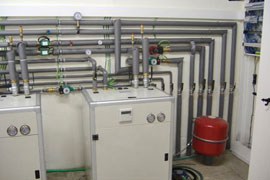The heat is on: Heat Pump Field Trials – Phase 2
The Energy Saving Trust (EST) has published a revised report on field trials of heat pumps in domestic installations to update its 2010 report.
EST has found that performance of heat pumps improve if they are properly installed and that 80% of users were satisfied with the performance of their heat pumps. EST Heat Pump Trials.
Based upon the results of its study, the Energy Saving Trust is convinced that heat pumps can play a significant part to help the UK reach its targets for reducing carbon emissions. Heat pumps can provide an effective, efficient solution for heating in many homes.
The original EST report drew some fairly obvious conclusions:
- Heat pumps are sensitive to design and commissioning
- Responsibility for the installation should be with one company
- Properly designed installations of ground source heat pumps work well
You can download the full EST report The heat is on which includes some general explanations of heat pumps. However, we think you will learn far more about heat pumps from this website, including the page on Thermalbanks.
ICAX specialises in large scale installations and uses heat pumps to extract heat from ThermalBanks. We would never use a heat pump to extract heat from the ground in winter without having any mechanism to save heat in the ground in summer – otherwise we would be in danger of only achieving the low level of performance found in the EST field trials.
One of the clear lessons of the domestic field trials is that heat pumps need to be carefully specified by knowledgeable installers: without the right advice you may not achieve the savings in running costs and savings in carbon emissions you are looking for.
How to improve the performance of heat pumps
The key to getting good performance from a heat pump is to understand the strengths and weaknesses of heat pumps and work with these instead of trying to fight them. You should aim to reduce the “uplift” required between the input temperature (from the ground) and the output temperature (to the building).
Underfloor heating works well with heat pumps because UFH can be effective at a low output temperature (35°C – 40°C) compared to radiators which usually require 65°C to be effective.
A well insulated building will need less heat and is therefore more suited to use of UFH.
UFH is a more gentle form of heating that can be operated for longer hours than gas fired radiators. Gas fired heating produces a higher level of heat (and draughts!) in shorter bursts.
The input temperature from outside is also important. When the outside air temperature is below freezing an air source heat pump will be less efficient than a ground source heat pump.
The input temperature from the ground will depend on the design and installation of the ground loop. As the GSHP extracts heat from the ground the ground temperature will fall and become less efficient. If the ground loop is too small the GSHP performance will suffer badly, especially in the later half of the winter.
ICAX installs heat pumps in larger projects where the economies of scale allow heat pumps to work more cost effectively than in domestic installations. ICAX has also developed a number of techniques to improve the performance of heat pumps in these large-scale projects. ICAX uses solar thermal collectors to store summer heat in Thermalbanks so that ICAX systems can benefit from higher ground temperatures in winter and thereby double the CoP of its heat pumps.
ICAX performs a full thermal modelling simulation of each installation in the design phase to verify that a well balanced system is delivered.ICAX Projects: Toddington | Howe Dell | Hiroshima | Garth | Merton | Suffolk One | Wellington | Tesco Greenfield
See Ground Source Heating Ground Source Cooling Ground Source Energy

